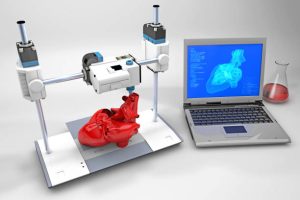Step into the future of healthcare, where breakthrough technologies are quickly becoming the cornerstone of medical advancements. These innovative tools and applications fundamentally change how doctors diagnose, monitor, and treat patients, heralding a new paradigm of precision and personalisation in medicine. Let’s take you on a journey through the most remarkable technologies that 2023 has blessed us with, shaping a tomorrow brimming with hope and healing.
Where Diagnostics Meet AI
Contents
- 1 Where Diagnostics Meet AI
- 2 Telemedicine: Healthcare Without Walls
- 3 Wearables: Your Health on Your Sleeve
- 4 Personalised Medicine: Healthcare Tailored to You
- 5 Robotics and Prosthetics: The Bionic Age
- 6 3D Printing: Crafting Health Precision
- 7 Nanotechnology: The Tiny Titans of Treatment
- 8 Immunotherapy: Unleashing the Body’s Warriors
- 9 AR and VR: Healthcare’s Virtual Visionaries
- 10 Blockchain: The Fortress of Health Data

The convergence of artificial intelligence with medical diagnostics is nothing short of breathtaking. Deep learning algorithms are sifting through mountains of data to unearth subtle patterns impossible for the human eye to detect. What does this mean for us? A world where the mysteries of our health are unravelled swiftly, paving the way for swift healing.
Consider the power of early disease detection. We now have technologies at our fingertips that can detect conditions early on when treatment is more likely to be successful, all while becoming increasingly accessible. It is not just about detecting what ails us anymore, but about foreseeing it – a true game-changer in the medical field.
Take, for example, technologies that are changing the game in cancer detection. Liquid biopsies represent this innovation: simple blood tests that hold the power to detect cancer swiftly and less invasively, shining a ray of hope for countless patients.
Telemedicine: Healthcare Without Walls

Telemedicine is breaking barriers, connecting patients to care wherever, and whenever. Easy-to-use apps have made it possible for you and me to tap into the expertise of healthcare professionals from our living room couch, changing the game for those in far-flung areas or juggling busy schedules.
But it’s not just about convenience. With telemedicine, the watchful eyes of healthcare professionals can now monitor chronic conditions from afar, ensuring that patients get the ongoing support they need to manage their health. It’s like having a doctor in your pocket, attentive around the clock.
Yet, with all its promise, telemedicine still faces hurdles. Getting the tech to everyone and ensuring it doesn’t replace but enhances the sacred patient-doctor relationship is the balancing act we must perfect as telemedicine continues to grow.
Wearables: Your Health on Your Sleeve

From the wrist to your fingertips, wearable technologies monitor your health stats in real-time, turning data into actionable health insights. These sleek devices are getting smarter, tracking an ever-expanding list of health metrics by the minute.
The true power lies in how these wearables talk to our healthcare systems, piecing together our health puzzle in real time. This not only gives us ownership of our health journey but also empowers doctors to make informed decisions with a holistic view of our health.
Yet, wearables are only as good as the accuracy and usability they bring to the table. As they evolve, these tiny titans of technology hold the potent promise of steering the ship of preventive medicine and chronic disease management.
Personalised Medicine: Healthcare Tailored to You

The field of genetics is unlocking the recipes that make us unique – and now, medicine is getting personal. Tailored healthcare that takes into account our genetic makeup is transitioning from a hopeful vision to a tangible reality.
Consider the realm of pharmacogenomics – a fine-tuned approach to medication that aligns with our unique genetic codes, minimising side effects, and maximising healing. Similarly, cancer treatment is morphing from a one-size-fits-all approach to one that respects the individuality of each tumour, of each person.
Big data’s grand role in personalising care cannot be understated. With an ocean of data at hand, trends, and treatment responses are clearer, steering the ship of personalised patient care to uncharted territories of efficacy and efficiency.
Robotics and Prosthetics: The Bionic Age

Surgical robots are the new hires in the operating room, bringing with them steady hands and eagle-eye precision. They enhance surgeries, making them minimally invasive and setting patients on the fast track to recovery – a stride forward welcomed by surgeons and patients alike.
The narrative of prosthetics is also being rewritten. Today, we have bionic limbs that move more naturally and are attuned to the wearer’s muscle signals. It’s about restoring not just mobility but independence and confidence, shifting the focus from what has been lost to what can be regained.
This is more than about individual recovery. It’s about potentially lessening the collective load on healthcare systems, and making independence and mobility accessible to all, regardless of physical challenges.
3D Printing: Crafting Health Precision

Imagine a world where life-like prosthetics and medical devices spring to life straight from the printer. That’s the realm of 3D printing in medicine – a world where customization is king and the possibilities for patient care are as limitless as the imagination.
This innovation is transforming everything from how auditory aids fit to the making of dental devices, marrying comfort with efficacy. And it doesn’t stop there. Even complex devices like spinal implants are emerging from the printer, ready to improve lives.
Navigating the ethical and regulatory path of 3D printing is as complex as the technology is innovative. With the potential of printing human tissue on the horizon, it begs a cautious yet visionary approach to ensure that this technology heals without harm.
Nanotechnology: The Tiny Titans of Treatment

Imagine sending microscopic couriers to deliver drugs right where they’re needed. That’s the magic of nanotechnology. It’s the precision of treatment redefined, minimising side effects and maximising results, a microscopic revolution in the making.
Nanotechnology is even offering hope against the vexing challenge of drug resistance. These minuscule marvels have the potential to outmanoeuvre such resistance, shining as beacons of hope in the quest to turn incurable diseases into manageable ones.
Immunotherapy: Unleashing the Body’s Warriors

The trailblazers of immunotherapy are conducting a symphony of the body’s immune response, directing it to seek and destroy cancer cells. Craft a powerful narrative for each patient, scripting their story uniquely and tailoring treatments specifically to the immune cells that safeguard their health.
Groundbreaking medical technologies are spearheading this personalised approach, uncovering the unique genetic layout of tumours, and targeting them with laser-focused treatments.
This research paints a tapestry of hope, weaving together success stories in a growing field where the battle against cancer is turning a promising corner, buoyed by an understanding of the relationship between the body’s natural defences and its potential to combat disease.
AR and VR: Healthcare’s Virtual Visionaries

Don your virtual goggles and step into the operating theatre where AR and VR are changing the perspective on surgery. These visionary tools offer an unprecedented look into the body, overlaying digital information for a clear view of the task at hand.
Medical education is basking in the light of AR and VR too. Students are now practising intricate procedures in virtual worlds, honing their skills in an immersive, risk-free environment. It’s the intersection of technology and tradition, crafting a new breed of skilled surgeons ready for the complexities of real-life operations.
With these tools, the future of surgery is shaping up to be one of higher precision and better outcomes, where AR and VR are not just aides but mentors in the operating room, sharing a vision of safer, smoother procedures.
Blockchain: The Fortress of Health Data

In our digital age, safeguarding health data is critical, and that’s where blockchain comes in. With unbreakable chains of data and an ethos of decentralisation, it’s a digital fortress securing the lifelines of our information.
The medical world’s integration with blockchain is at the heart of forging a sacred bond of trust. It’s a pact that promises security and accessibility, ensuring that sensitive health records remain both shield and sword against misuse and breaches.
Blockchain serves as a lighthouse in the ebb and flow of data privacy concerns, guiding the way toward a new era where individuals regain control over their medical history and restore trust in the digital landscape.

